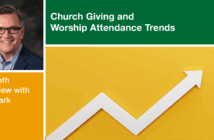Rebekah Simon-Peter outlines four models small churches have used to survive the pandemic — the church at home model, the shut-in model, the never shut down model, and the hybrid model. She shares tips for how these approaches can keep worship alive and Christian education vibrant in smaller congregations.
Small churches are often isolated from each other, so you may not be aware of how other congregations are coping. The first thing I want you to know is that you are not alone. Through my work with congregations in Creating a Culture of Renewal®, we have gained wisdom from small churches around the country who are effectively using the following four models.
1. The church at home model
The church at home model is similar to a home school model and is especially useful if your church is shut down. Here, worship and Christian education is provided at home in a family setting. In a way, this is the ultimate small church. The value of families worshiping together cannot be underestimated.
Small churches can minister to the “church at home” by delivering weekly or monthly handouts that follow lectionary or seasonal themes. Coordinate worship and Christian education materials so they build on each other. Several outlets such as Cokesbury provide free downloadable resources for just this purpose. The Upper Room or other subscription-based devotionals can fill in the gaps. Be sure to include an offering envelope, as well as letters of communication, if email is not being used.
2. The shut-In model
If your congregation has reopened but older members are reluctant to return to in-person worship, consider the shut-in model. Similar to the church at home model, the shut-in model is delivery-based. Just as you ministered to shut-ins before the pandemic, deliver bulletins, Upper Rooms, and pre-packaged consecrated Holy Communion to these folks. The only differences are the need to socially distance and the potential reluctance to have nonfamily members enter the home. Be sure to include newsletters and an offering envelope in your delivery. If internet service is not available in your setting, both the church at home and shut-in models can benefit from a conference call number. This could be used for teleconference-based prayer, worship, and brief Christian education sessions.
3. Never shut down model
Congregations that never stopped meeting or continued to meet for the most part will want to pay special attention to protecting at-risk populations. This includes folks who are unvaccinated. Be sure to ask people to mask, to sit six or more feet apart during worship, and to use hand sanitizer. The value of meeting together, even under these conditions, cannot be over emphasized. People-to-people contact, worshiping in community, and the joy of seeing familiar faces — while keeping safety practices in place — boost the spirit and make glad the heart.
4. Hybrid model
If and when your small church begins to meet again, don’t be surprised if some of your people don’t return. They may opt out either because of safety concerns or because they just got out of the habit. In this case, developing a hybrid model of worship and education may be your best bet. If the internet is not accessible, your hybrid model would be ongoing delivery to the church at home or to the shut-in folks even as the rest of your congregation worships in person. Again, be sure to mail offering envelopes or give people an opportunity to give online. If you have internet access, use that to create a hybrid community that allows for people to participate online or in person. You can livestream worship and Bible Study on Facebook or record and post to YouTube.
Effective communication is key.
Whatever model you are using, there is one challenge that you must avoid. This is the tendency of many churches to UNDER-communicate. Churches that under-communicate assume that everyone already knows what is happening. This dangerous assumption ensures that you will leave people out as you make changes. When you lose contact with your congregation, you weaken the bonds that will bring people back when it’s safe. Instead, regular communication allows you to stay connected with your people and to implement the worship and Christian education tips outlined above.
It’s time now to plan your next outreach, whether a mailbox delivery for Thanksgiving, a bulletin, or a letter to your congregation. Lead with love, follow up with invitation, and round it out with a call to action. Ask people to pray for one another, to contribute to a food bank, or to call their neighbor. Also, don’t forget to ask them to contribute to the work of the church. Just because folks aren’t meeting in person doesn’t mean they can’t stay connected.
This article is adapted from a blog post, “Small Church Worship and Education During the Pandemic” originally published on rebekahsimonpeter.com. Used by permission. If you are looking for the next best practice as you survive the pandemic, Rebekah Simon-Peter is offering a brand new online short course starting in December 2021: Church Growth: From Barriers to Breakthroughs.
Related Resources
- 3 Unique Gifts of the Rural Church by Allen Stanton
- Small Church Big Impact by Blake Bradford
- “Building Thriving Rural Congregations,” a Leading Ideas Talks podcast episode featuring Allen Stanton






